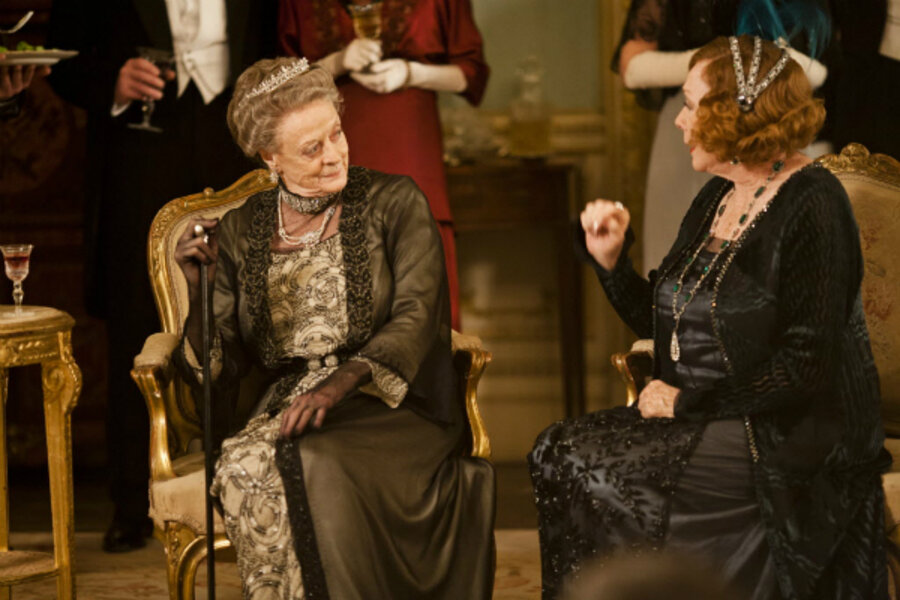Downton Abbey: Where would they vacation in America?
Loading...
| Newport, R.I.
If the Crawley family of "Downton Abbey" were American, they'd summer at Newport.
The wild stateside success of the British period drama about post-Edwardian aristocrats and their live-in help has piqued interest in the life of servants in the Gilded Age mansions of the seaside city. The nation's wealthiest families built Newport "cottages" in the 19th and early 20th centuries and would move their households here — servants, silver and all — from New York and elsewhere in the summer to enjoy the ocean breezes and society scene.
Just as the Downton servants develop relationships downstairs — think the frustrated love triangle of kitchen maids Daisy and Ivy with footman Alfred— servants in Newport carried on a lively social scene of their own. Many of their stories have begun to emerge after digging by researchers at the Newport Preservation Society, which owns several mansions. Newly discovered photographs, documents and family histories have inspired the creation of a tour about servants in one of Newport's most picturesque houses, The Elms, becoming one of the society's most popular tours.
Many mansions have been open to the public for decades, but with a focus on the wealthy families who lived there. Newport's grandest mansion, The Breakers, in recent years incorporated some information about servant life in its audio tour. But the new guided tour at The Elms centers squarely on servants and allows visitors into rarely seen parts of the mansion, including servants' quarters, the kitchen and the massive boiler room, where coal would be brought in through a tunnel that goes under the garden wall.
Meg A. Watt, a "Downton" fan from Stroudsburg, Pa., took the tour last spring, not long after it was started. The owners' side of the house is opulent with marble and gold. Just steps away, hidden behind doors, are plain hallways and rooms for use by the servants, she said.
"It gives you a completely different perspective," Watt said.
The Crawleys' own American grandmama, played by Shirley MacLaine, owns homes in New York and Newport. The city is even mentioned on the show from time to time, including by Lady Mary Crawley, who considers fleeing to America to wait out a scandal involving the death of a Turkish diplomat in her bed.
"It'll be dull but not uncomfortable," she remarks to her lady's maid, Anna, who asks to come with her.
They end up staying at Downton Abbey. But if they had gone to Newport, they might have found a house much like The Elms.
Completed in 1901, it was built as a summer home for Edward Julius Berwind, a coal magnate, and his wife. It was the first home in Newport that was completely electrified, boasted modern amenities such as an ice maker and telephone, and was even featured on the cover of Scientific American. The Elms was used as a residence until 1961.
The tour begins at the servants' entrance, which is covered by an arbor and therefore hidden from view so residents upstairs wouldn't see deliveries. The guide then leads people up five flights of stairs to the servants' quarters, leading visitors to wonder how someone like Downton's war-wounded Mr. Bates could manage such exertion several times a day. (An elevator is now available for those who need it.)
One servant's bedroom is furnished as it might have been at the time. One displays census records that show the names, occupations and countries of birth of the Berwind household's domestic staff: around a dozen maids, footmen and others from countries as varied as England, France, Germany and Sweden, a difference from the servants at Downton, who are mostly English, save a few including the Scottish housekeeper, Mrs. Hughes, and Irish chauffeur turned son-in-law, Tom Branson.
Another includes the story of the dismissal of the entire staff in 1902 after they asked for more time off, said John Tschirch, director of museum affairs at the mansions, who did much of the research on which the tour is based. The Berwinds replaced them with new servants brought up from New York.
Other bedrooms display photos of servants, as well as journals and other documents, many provided by servants' descendants. One shows a maid standing next to a rocking chair on the home's roof, which was a de facto porch for the staff. In the window next to her are flowers in pots.
In another photo, the Berwind household's longtime butler Ernest Birch, who married the cook, sits on a chair outside the mansion surrounded by footmen. One, much like Downton's footman-turned-valet-turned-assistant butler Thomas, seems to be throwing a little attitude.
Census records from 1895 show that around 10 percent of the population in Newport was domestic servants. Tschirch said staff would have "kitchen ratchets," parties in the kitchens of the different mansions, with food galore.
"That's where all the gossip was," he said. "You think of a social summer resort, the stories the servants could tell about each other, the people in town, the fashion."
Much of the information has come from servants' relatives who heard the Preservation Society wanted to hear from anyone who had lived or visited there, not just the owners. Tschirch said all kinds of family lore has surfaced, including a story about the cook, Mrs. Birch, whose finger was clawed by a lobster and had to be removed.
They're still looking for more, he said.
"The descendants," Tschirch said, "are beginning to feel that these houses are part of their family histories, too."





